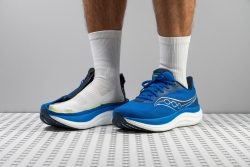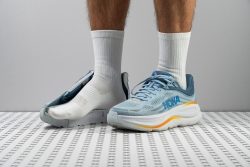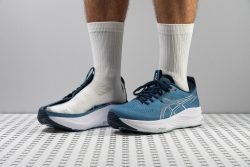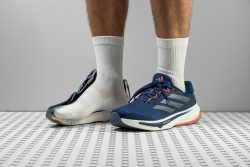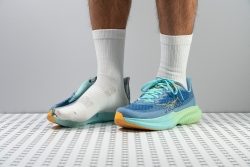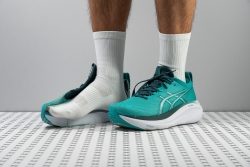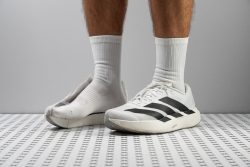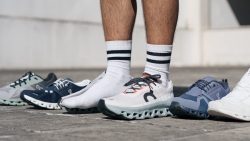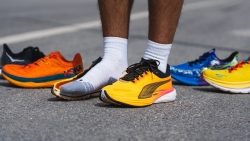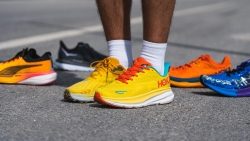7 Best Running Shoes For Plantar Fasciitis in 2025
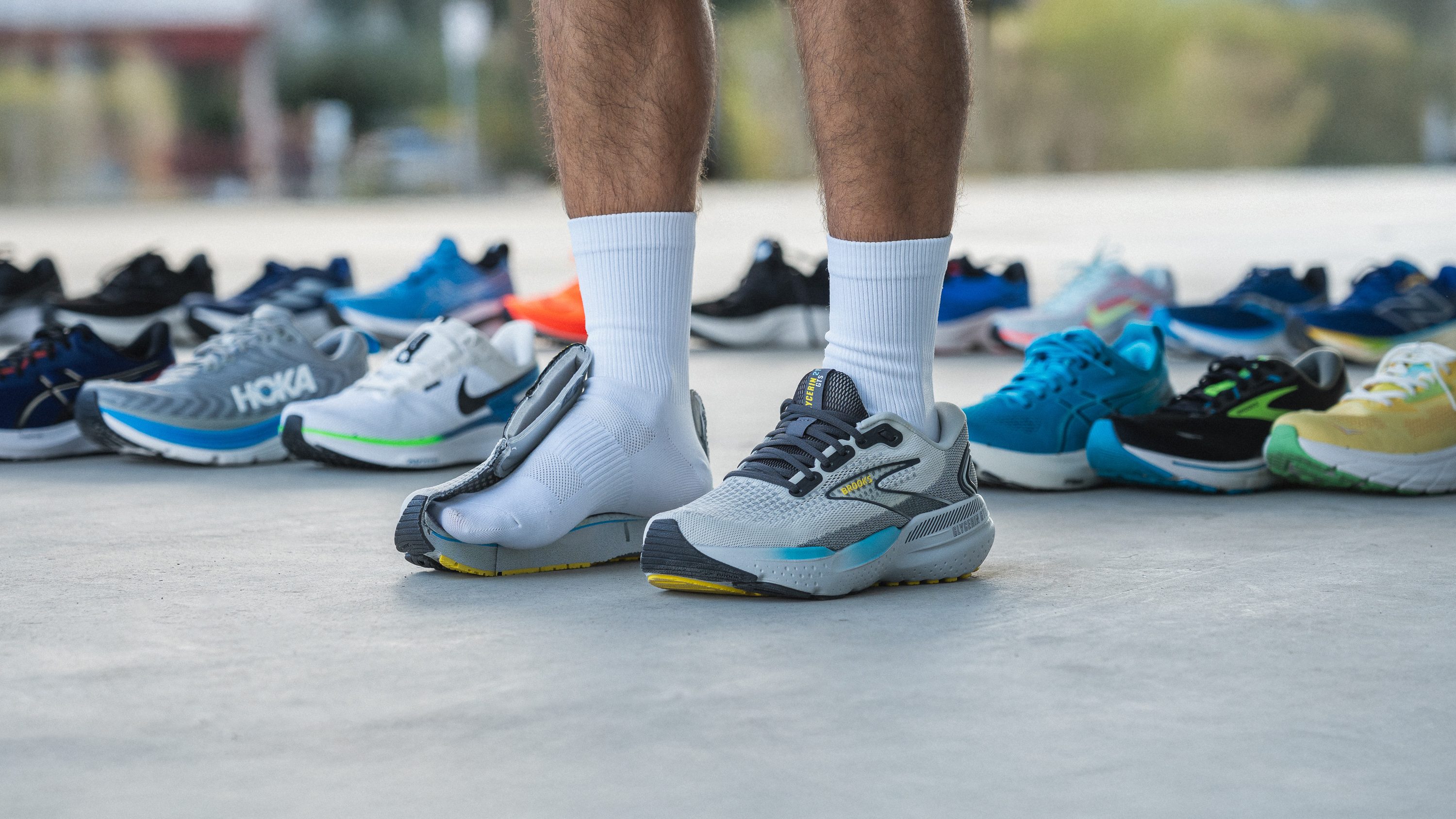
We buy shoes ourselves. We earn commissions when you buy through us, at no extra cost. Why trust us
Based on studies, plantar fasciitis affects 1 in every 10 adults, both men and women. Whether you are an athlete or not, one of the ways to reduce plantar fasciitis is to wear comfortable shoes.
In our lab and on the runs, we have tested running shoes that are recommended for plantar fasciitis to help you find the best ones. And because you may have different preferences regarding the level of support, cushioning, or price range, we have selected our top picks in different categories.
And if you want to learn more about this foot condition, read our in-depth article on plantar fasciitis.
How we test running shoes for plantar fasciitis
It is our mission to help you find the best shoe to alleviate the discomfort of plantar fasciitis. Given our extensive knowledge base, we have developed a comprehensive review methodology to find out which shoes work the best.
- To avoid bias, we purchase all running shoes with our own money.
- We log miles in each pair, indoors and outdoors, and on roads and trails.
- We cut the running shoes open and measure 30+ different parameters.
- We summarize our data and observations in an extensive review.
Best running shoes for plantar fasciitis overall
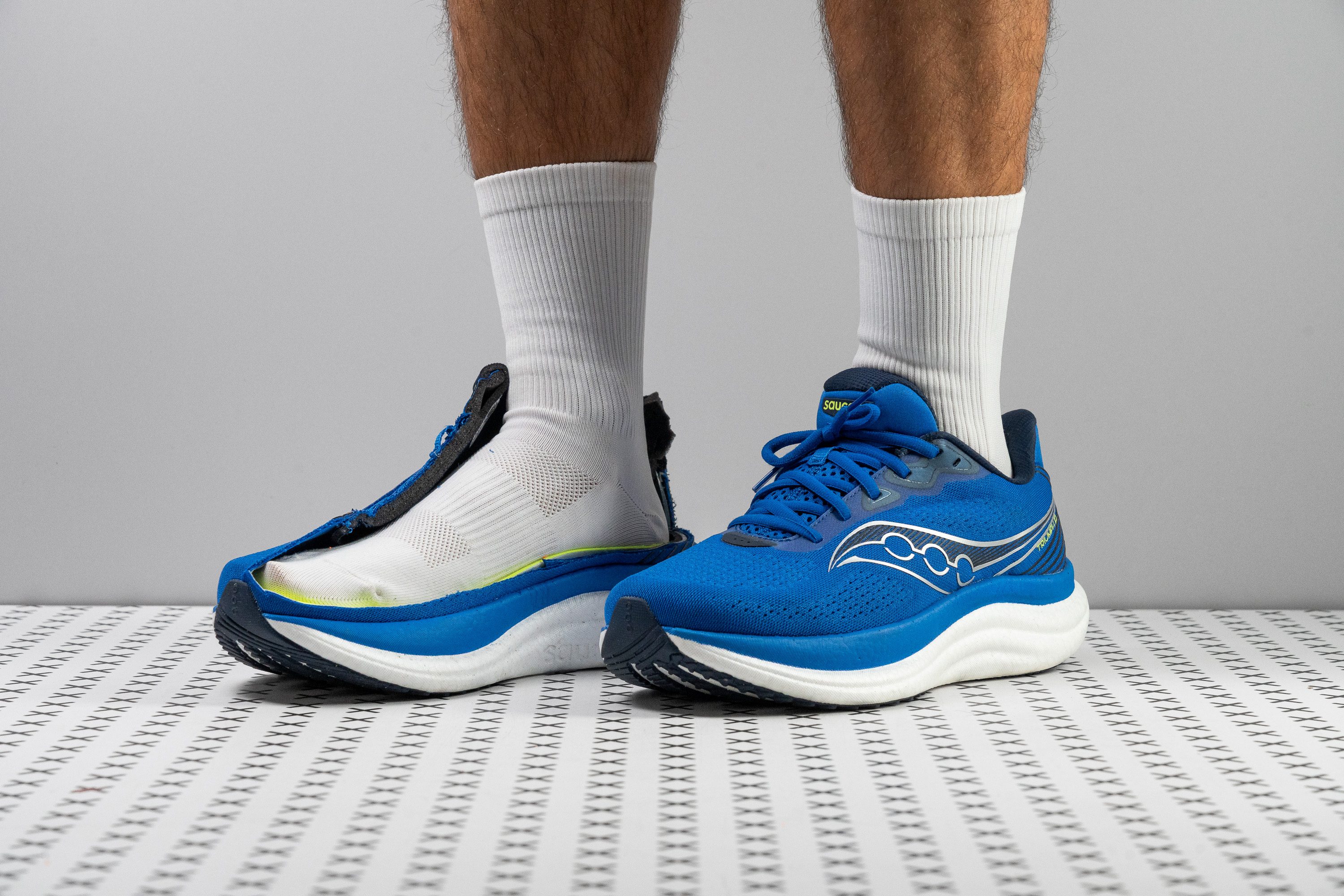












































What makes it the best?
Blending solid support and comfort in our runs, we crowned the Saucony Triumph 23 as our top plantar fasciitis running shoe. Featuring a wide, stable base, it keeps our feet in place. Moreover, our lab results prove it's easy on the feet with its highly-cushioned, shock-absorbing midsole.
Each landing feels secure thanks to the raised midsole sidewalls and broad platform to keep our feet inside the shoe. This prevents spillovers and excessive foot rolling, with our caliper measurements of 124.0/98.9 mm confirming its spaciousness.
To boost comfort, the heel is a massive 42.3 mm to cushion our landings. Paired with a 32.2 mm forefoot, the 10.0 mm drop puts us in an ergonomic position so that there’s less pressure in the heel area and reduces the chance of inflammation.
Besides the foam thickness, the midsole is capable of reducing the brunt of landing impact on our muscles, proven by remarkable shock absorption scores of 149 SA in the heel and 136 SA in the forefoot.
With its middle-of-the-road 3/5 breathability score, we think ventilation could still be improved. Best to wear this pair during cooler seasons.
Pros
- Amazing energy return
- Lighter than previous version
- Huge cushioning for long runs
- Wide platform makes it really stable
- Full PWRRUN PB midsole
- Premium sockliner
- Durable build overall
- Versatile enough for daily wear
- Consistent performance in cold temps
- Excellent grip
Cons
- Price increase
- Ventilation could be improved
- PWRRUN PB may feel firm to some
- Bulkier build limits agility
Running shoes for plantar fasciitis with the best shock absorption
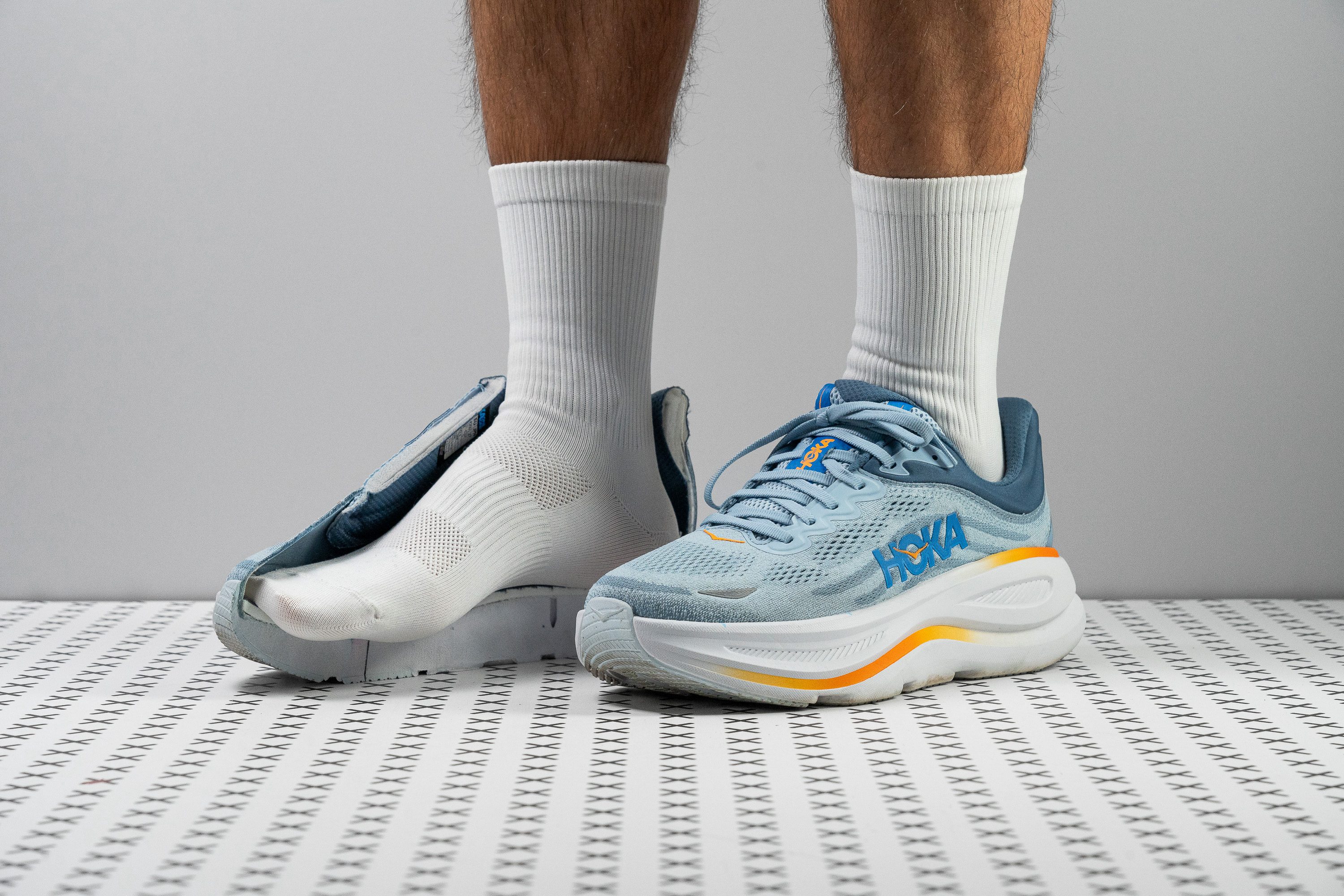

















































What makes it the best?
No shoe can match Hoka Bondi 9’s shock absorption among our lab-tested running shoes for those with plantar fasciitis. It is the real deal not only in securing our foot alignment but also in protecting our joints. We love how it delivers support without compromising durability and comfort, as proven by lab results.
We experienced muted ground impact and subtly guided movements in our tests. Diving deeper into the cushion, we found it elevates the experience with an above-average 41.3/32.2 mm stack height when stable shoes tend to be grounded. No shortage of comfort here as our feet enjoyed maximum protection! Measuring its shock absorption, it impressed us with an undeniably high 146 SA score, 15.0% above average.
The midsole sidewalls and wide dimensions form the core support structure and boost rigidity. Our caliper shows the base is massive at 123.2/100.9 mm vs. the 114.1/90.6 mm average. Our manual test shows outstanding resistance to twisting, earning a top 4/5 torsional rigidity rating.
Underfoot, the outsole shows exceptional resilience in our Dremel test. With its minimal 0.9 mm wear, we’re assured it won’t experience premature damage.
However, we can’t recommend this shoe to runners craving a speedy ride. The moment we start to pick up the pace, its heft becomes apparent.
Pros
- Endless cushioning
- New supercritical EVA midsole
- Amazing step-in comfort
- Doubles as a walking shoe
- Stable for its height
- Built to last
- Excels at slow-and-steady paces
- Well-designed heel collar
- Lighter than v8
Cons
- Not for wide feet
- Still feels heavy and clunky underfoot
- Drop measurement differs from stated
- Non-gusseted tongue
Running shoes for plantar fasciitis with the best stability
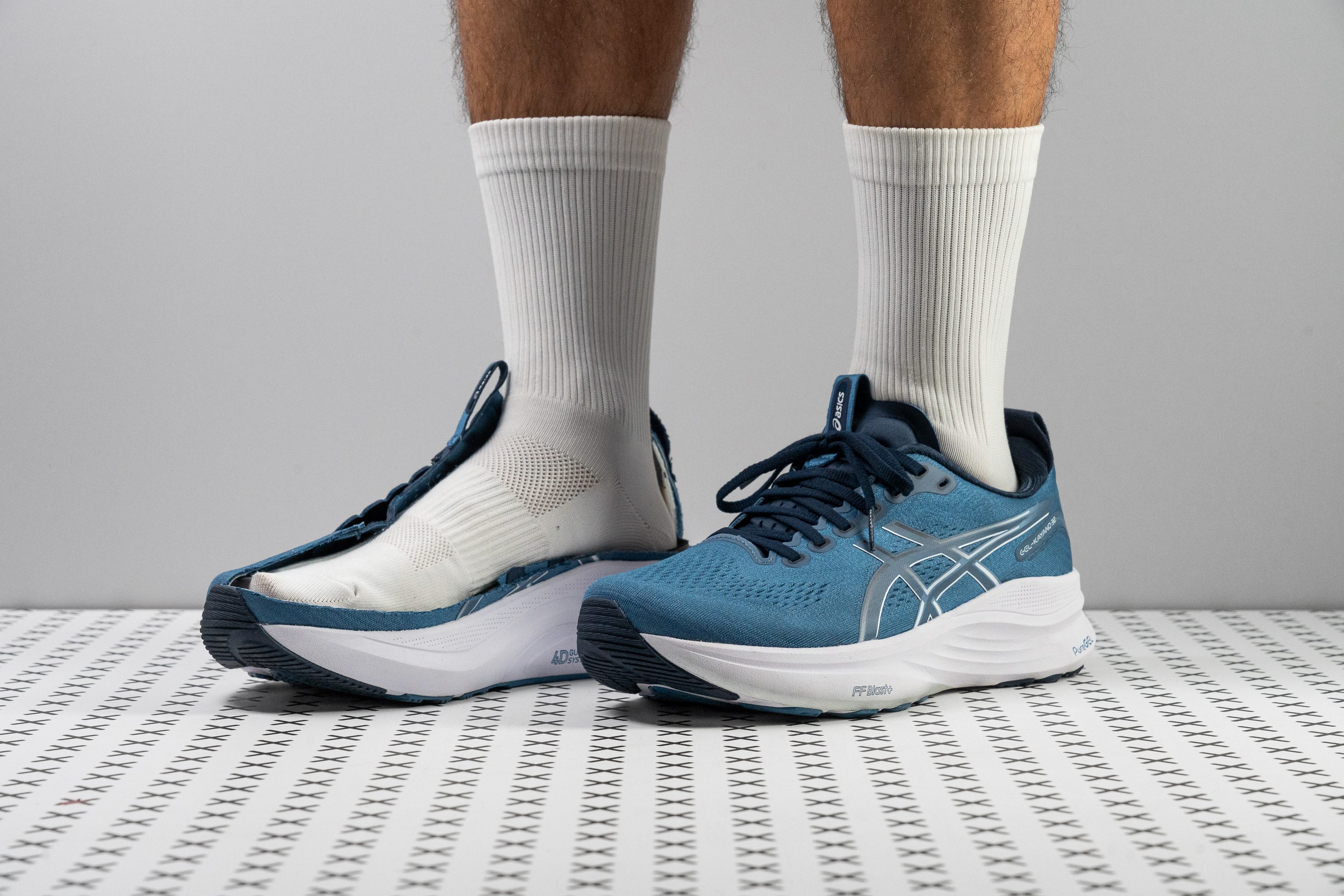













































What makes it the best?
Those of us with plantar fasciitis greatly appreciated the 32nd Gel Kayano’s one-of-a-kind stable ride. It's significant amount of cushioning felt like home, while its revolutionary 4D Guidance System maintained our proper foot alignment. Even our lab results prove it’s easy to fall in love with this shoe’s ideal balance of comfort and support.
GK32 aced its stability features, namely the non-intrusive 4D Guidance System and the extensive landing base. The former uses a softer foam under our arches for custom support and protection, relieving us from unwanted pressure and pain. Meanwhile, the midsole sidewalls and extra-wide 119.8/97.2 mm forefoot and heel reassure us with steady landings.
This ASICS redefined the traditional stability shoe by adding tons of comfort to its midsole. The ride feels highly plush and impact-protected with its tall 39.9/30.6 mm stack packed with the brand’s softest foam. We ran long miles without counting since our legs remained fresh, proven by their high shock absorption score of 133 SA.
We think the outsole could have been thinner to trim the shoe’s weight. Those who don’t like a bottom-heavy shoe should skip this pair.
Pros
- Amazing shock absorption
- Plush and breathable upper
- Made to last
- Dependable for most pronators
- Heavy-duty outsole with excellent grip
- Stable as a table
- Pillow-soft heel padding
- Improved fit
- Excellent build quality
Cons
- Not for soft-foam lovers
- Bad energy return
- Overpriced in Europe
Best running shoes for plantar fasciitis and wide feet
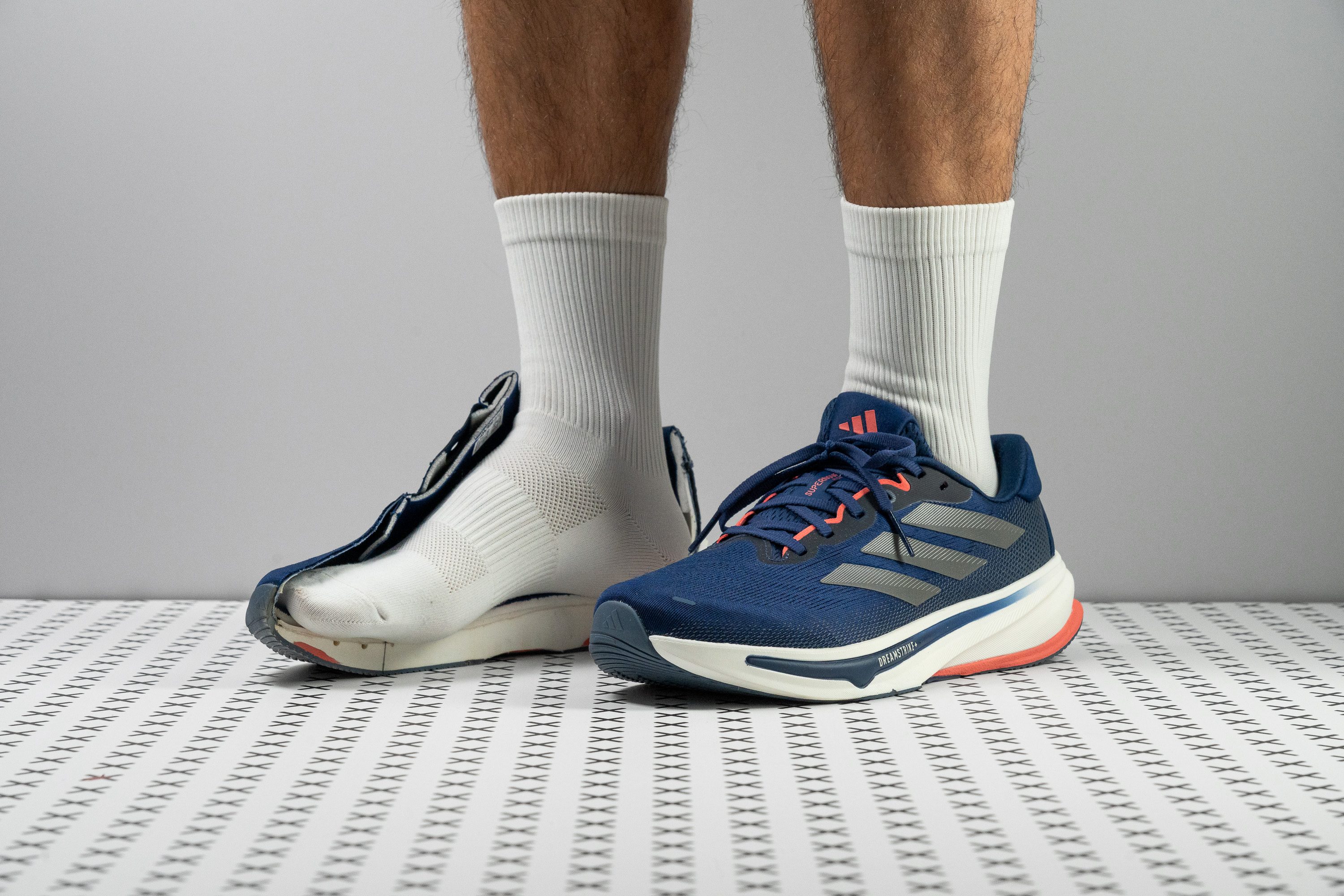















































What makes it the best?
After miles of running and hours of lab testing, the Adidas Supernova Rise 2 emerged as our best for wide feet plantar fasciitis running shoe. It offers the right combination of gentle support and comfortable cushioning that relieves plantar fasciitis-afflicted runners. With its exceptionally light build, it feels easy on the feet.
We measured our solidified gel mold to confirm the roominess we enjoyed. True enough, the widest part is 98.7 mm, much more forgiving than the 95.1 mm average. Supernova Rise 2 can easily accommodate those with bunions or broad feet.
At 9.1 oz (257g), this shoe is light for the support it offers. Its Support Rods and small sidewraps in the heel work together to promote balance and sure-footedness. Our manual test confirms the heel is stiff with a 4/5 rating. This non-intrusive innovation doesn’t demand much attention, yet we know it is there when we need it.
While the midsole has moderate height, it features a steep 9.5 mm offset that reduces pressure on our heels. As a result, we avoid triggering any inflammation, relieving our muscles during long runs.
While the ball of the foot area is wide, its toebox is surprisingly narrow. Therefore, we recommend those with square-shaped or high-volume toes to check other options to avoid pressure points.
Pros
- Lighter than version 1
- Comfortable yet breathable upper
- Cold-proof PEBA midsole
- Stable ride with Support Rods
- Reflective accents for night visibility
- Maintains competitive price tag
- Responsive Dreamstrike+ foam
- Flexible, natural running experience
- Great for walking
Cons
- Outsole lacks Continental
- Not cushioned for forefoot strikers
- Still lacks a gusseted tongue
Best lightweight running shoes for plantar fasciitis
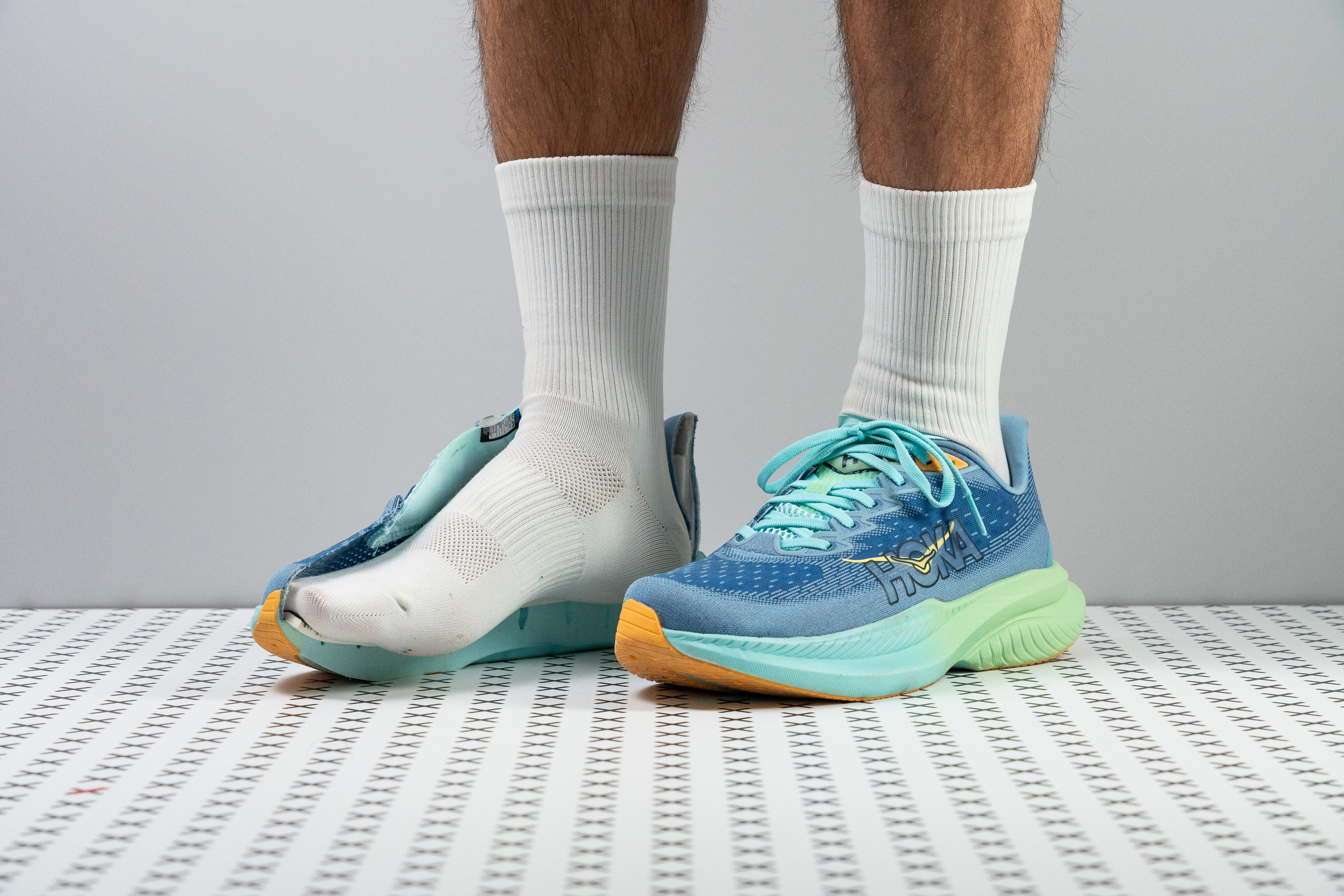





















































What makes it the best?
Hoka redefines the traditional heavy stability shoe with the Mach 6. A breath of fresh air on our feet, it offers consistent and subtle support without losing its agility and plush sensation. The lab results show this, but it's our runs that cement Mach 6 as the best lightweight shoe for runners with plantar fasciitis.
While most stability shoes weigh above 10.1 oz (286g) and the average running shoe is 9.3 oz (265g), Mach 6 boasts a feathery 8.2 oz (232g) build. Further enhancing its effortless feel is its flexible midsole. In our bend test, we verified that it’s 9.9% more pliable than average, boosting its versatility.
Mach 6 offers leg-saving comfort through its high shock absorption levels, backed up by its 135/114 SA scores. To enhance comfort, we also measured a steep 9.6 mm heel drop, which brings even weight distribution and less localized tension in the rear.
We experienced confident footing throughout our runs despite the Mach 6 having average dimensions. Its gentle yet reliable lateral stability comes from its resistance to twisting, proven by our manual assessment with a 4/5 torsional rigidity rating.
While the Mach 6 feels agile, it lacks space for broad-footed runners. We suggest looking for a roomier shoe for better comfort and stability.
Pros
- Really lightweight
- Fantastic outsole
- Exciting ride
- Highly cushioned
- Great for heel strikers
- Handles faster paces
- Superb lockdown
- Excellent value at $140
Cons
- Drop varies from stated
- Tapered toebox
- Thin tongue
Running shoes for plantar fasciitis with the best traction
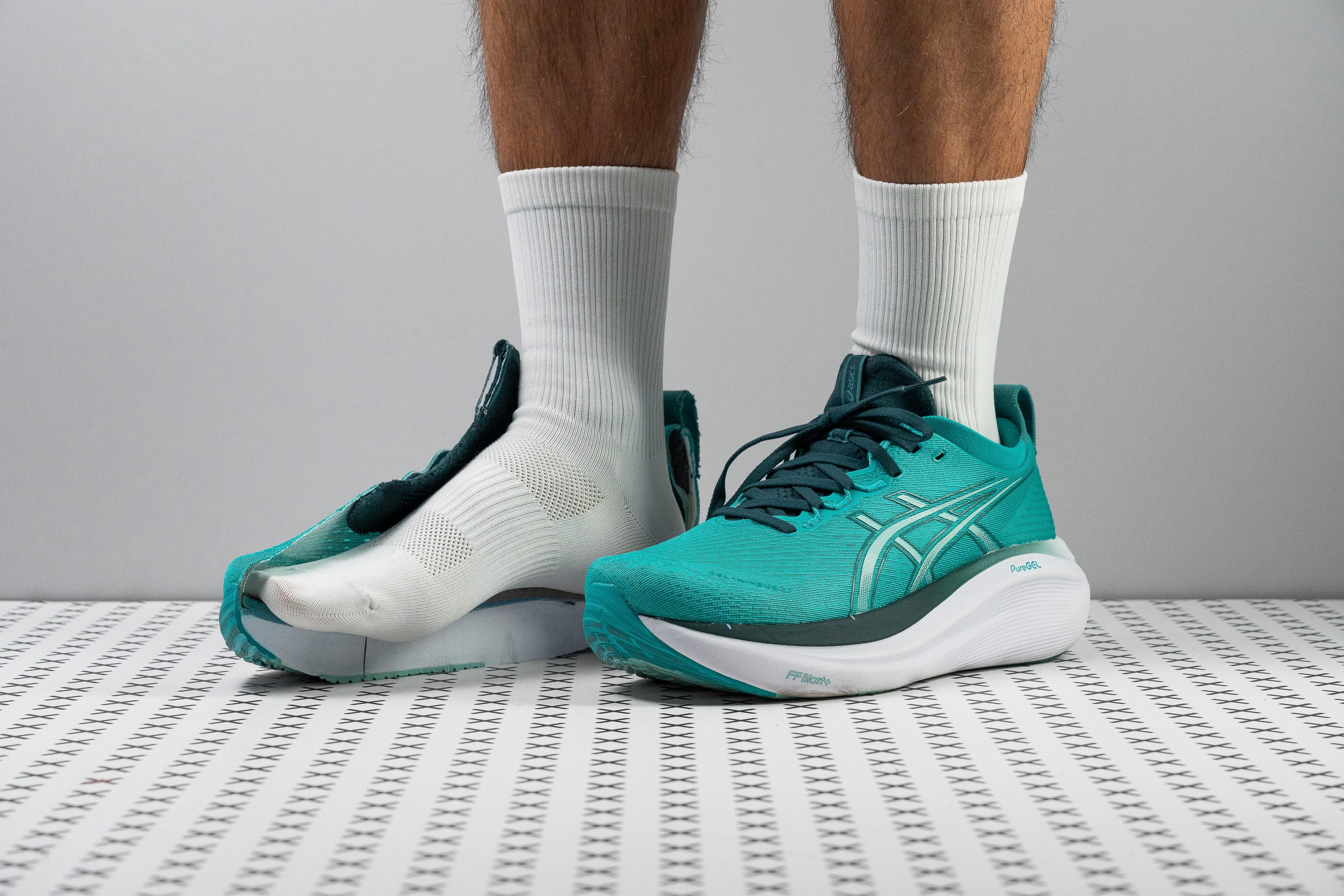
















































What makes it the best?
The ASICS Gel Nimbus 27 offers steady footing and undeniable long-distance comfort, yet it stood out in the lab with the best traction among plantar fasciitis running shoes. Its sticky outsole, together with its rock-solid torsional rigidity, brings a stable ride, while the generous cushioning takes care of our joints.
We put the Hybrid ASICSGRIP under our wet-condition test, and it recorded a high friction coefficient of 0.84. At this rate, it offers 78.7% stronger grip than average, explaining why we felt confident passing through slick roads.
On days we run longer than planned, our legs have no complaints. The Gel Nimbus 27 offers abundant cushioning, with a caliper reading of 42.7/34.4 mm. Other than that, the foam itself offers otherworldly shock absorption, scoring 136 SA in both the heel and forefoot. The PureGEL insert in the rear offers softer landings and prevents localized tension in the heel.
To balance potential wobbles from its height, it has reinforced midsole sidewalls that increase the shoe’s structure. In our manual assessment, the midsole has no give to twisting, so we gave it the maximum 5/5 torsional rigidity score.
Unfortunately, Gel Nimbus 27 is more of a steady companion than an exciting shoe. Those seeking more bounce and responsiveness can check alternatives.
Pros
- Even more foam underfoot!
- Premium-feel, breathable upper
- Fantastic stability
- Improved toebox with extra wiggle room
- Flexible knit tongue
- True maximalist comfort for recovery runs
- Amazing heel lockdown
- Top-tier grip
Cons
- Feels bulky and heavy
- Minor price increase
- Lacks energy return
Running shoes for plantar fasciitis with the best energy return
































































What makes it the best?
With its long-distance-ready protection and propulsive ride, the Adidas Adizero EVO SL took us fast and far. The way it took care of our feet didn’t let any pain issues stop us, even emerging in the lab as the running shoe with the best energy return for runners dealing with plantar fasciitis.
The Adizero EVO SL features the Lightsrike Pro midsole, which explains the undeniable rebound in our runs. We double-checked using our energy return test and recorded massive scores of 74.3% in the heel and 70.3% in the forefoot. There’s no way this trainer feels dull underfoot!
Every dynamic stride is complemented with well-cushioned landings. The midsole itself reduces the stress on our muscles, backed up by its high shock absorption ratings of 147 SA in the heel and 126 SA in the forefoot. Moreover, the midsole has an 8.0 mm drop that reduces the load on our ankles and heels and makes our hips and glutes do the work.
To avoid losing our footing and further causing inflammation to our feet, the midfoot has a plastic shank for mild support. Furthermore, the midsole is twist-resistant, backed up by its 4/5 rating in our torsional rigidity test.
Unfortunately, the toebox is prone to premature wear with its low 1/5 durability rating in the lab. Those who often puncture uppers should find a trainer with more reinforcements.
Pros
- 100% Lightstrike Pro superfoam
- Exceptional value-to-performance ratio
- Low weight
- Ultra-breathable upper
- Unmatched versatility
- Agile and fun ride
- Handles short and long runs with ease
- Striking Evo 1-inspired aesthetics
Cons
- Poor-quality laces
- Short, non-gusseted tongue
- Toebox durability
Got plantar fasciitis?
There are many possible causes of heel and arch pain. The overused and possibly inflamed plantar fascia can cause pain under the arch and also under or around the heel.
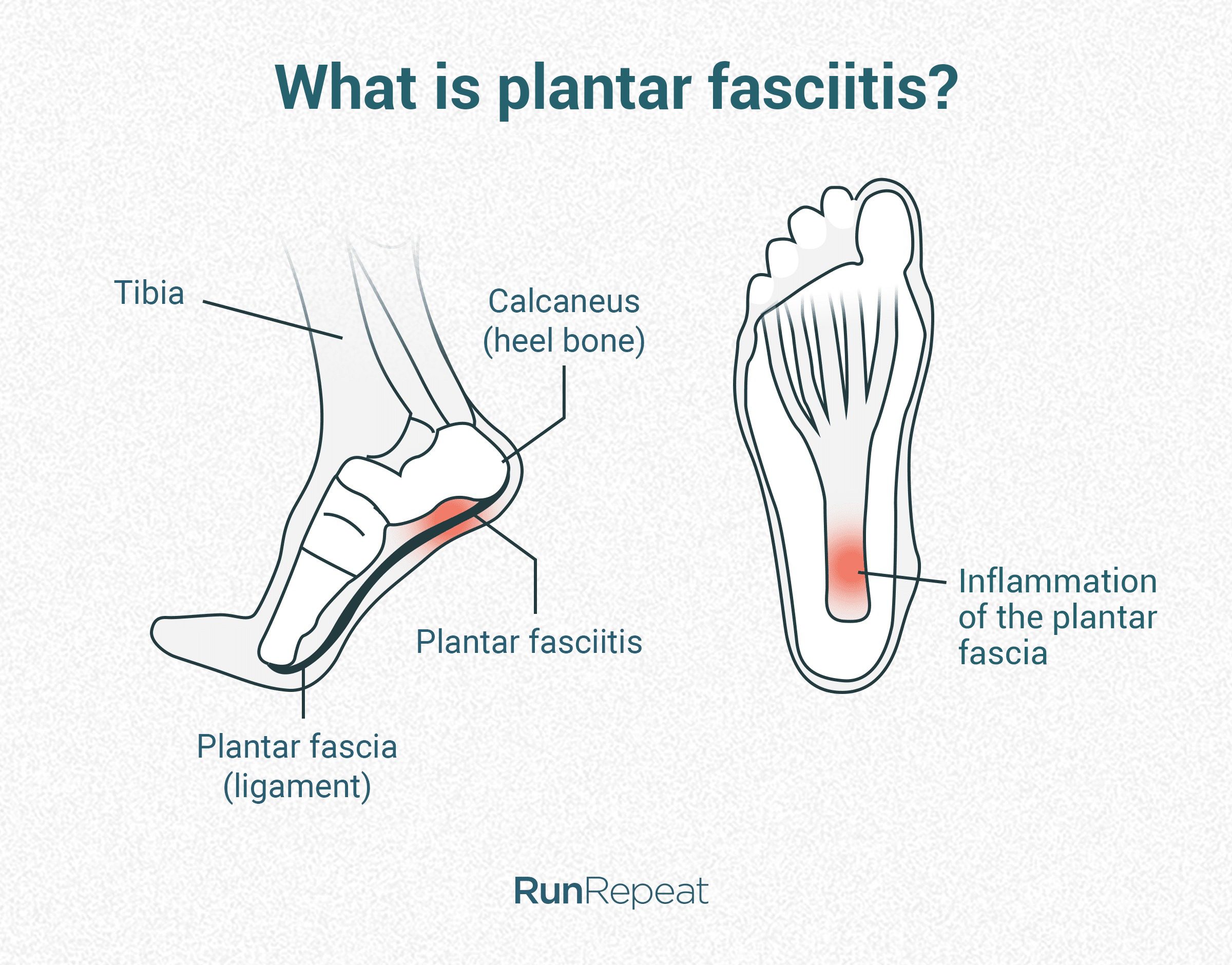
Sharp heel pain is usually the first sign of plantar fasciitis but not the only one, which is why it’s imperative to visit a podiatrist or a PT, ideally the one who works with runners, before deciding on the treatment and footwear.
This guide was written with runners with plantar fasciitis in mind and is not here to give medical advice.
How are PF shoes different from the rest?
When you have plantar fasciitis, what usually causes even more pain is running and walking in shoes that are barefoot or minimalist, that have no support because they are simply too flexible, and that are maybe even too soft. This makes your feet work even more, while what they actually need is some support and stability.
Running shoes for plantar fasciitis feel great because:
- the rigid platform feels stable
- the stiff heel counter cradles the heel and it locks it down, so there’s less movement and, therefore, less pain
- the base is soft but not too soft so that there’s no excessive motion and
- the heel drop is high because higher heel drops activate the muscles of the upper parts of the legs.
5 things to look for in running shoes if you have plantar fasciitis
Pain in the heel or along the arch can sometimes be immediately reduced, at least to some extent, when the proper running shoes are worn.
Based on all the research and our experience with plantar fasciitis and the pain it causes, in RunRepeat, we focus on these 5 things that get the shoes on the plantar fasciitis list:
- Cushioned shoes with good shock absorption: 115 SA is the minimum.
- Heel drop of at least 8 mm.
- Midsoles that are not too soft. We advise going for a minimum of 20 HA.
- Rigid running shoes, and here, we focus on torsional rigidity that needs to be in the 3-5 range (out of 5, where 5 is the most rigid).
- Stiff heel counters! Here, we also advise the 3-5 range (where 5 is the stiffest).
We dive deep into every section below.
Don’t run in minimalist running shoes if you have plantar fasciitis
Barefoot and minimalist shoes are too flexible, too low-to-the-ground, and too low-drop for runners with plantar fasciitis.

Minimalist shoes are rated on different aspects (stack height, drop, stability technologies, weight, and flexibility), and usually, they are very flexible, have a low drop, and have no stability technologies. This makes them not friendly for feet with plantar fasciitis.

The same goes for barefoot running shoes, a subgroup of minimalist shoes. They resemble barefoot running, which means the cushioning is barely existent, and the flexibility (both torsional and longitudinal) of the shoe and the heel counter is very high.
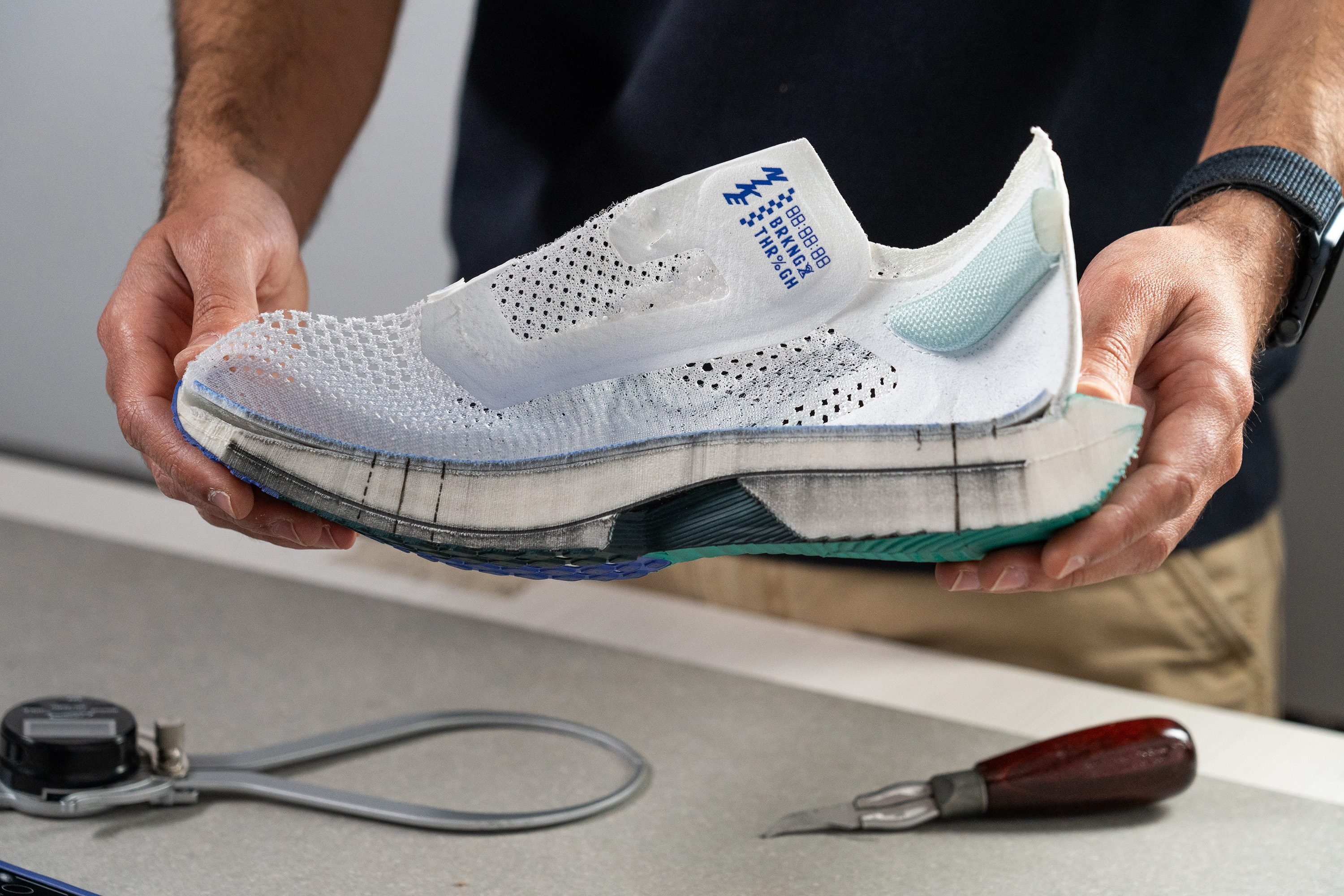
More stack height means more cushioning, and this is highly welcomed in running shoes for plantar fasciitis.
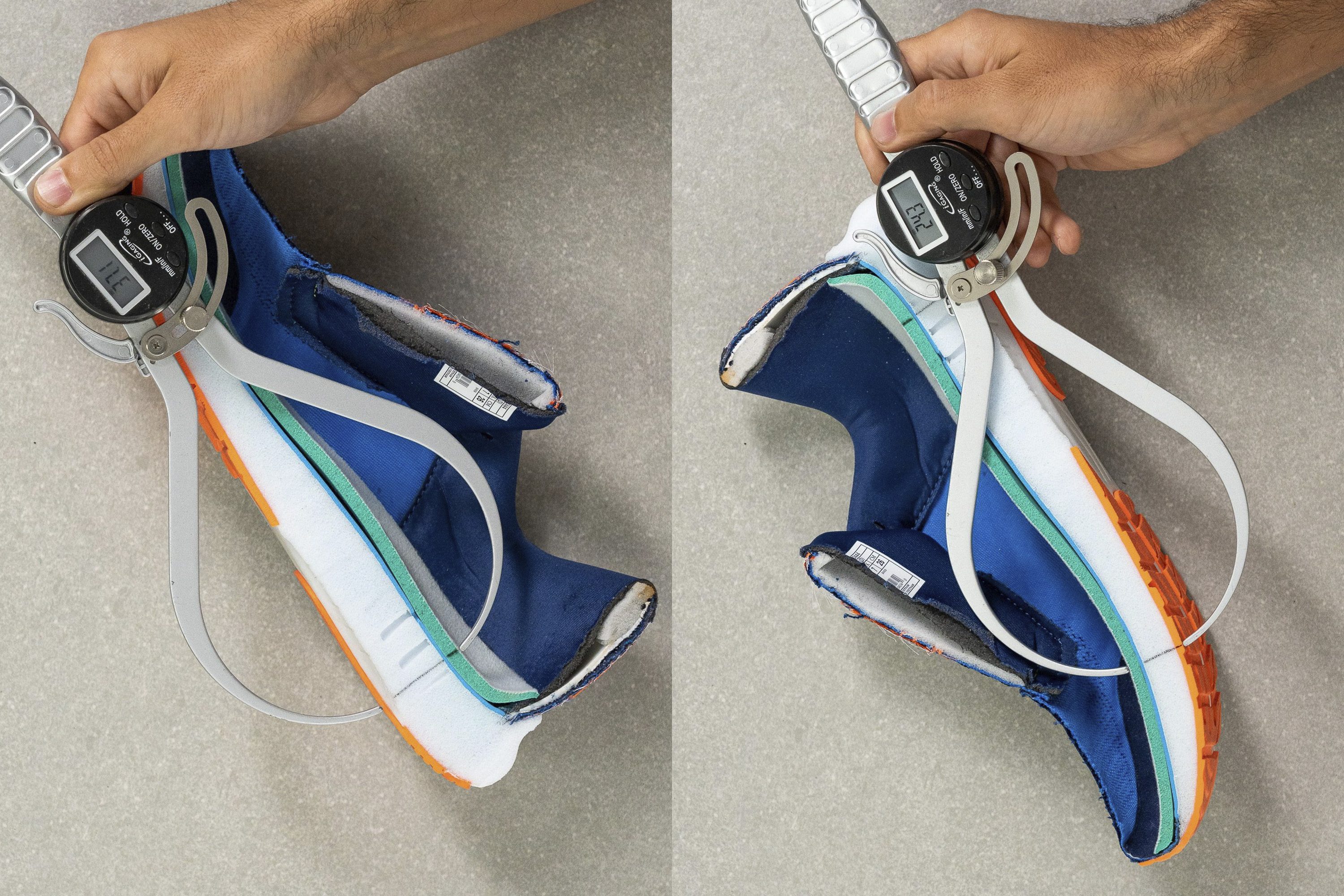
Find shoes with good shock absorption!
This is a better feature to rely on than the stack height or midsole softness. It is because shock absorption tells us how protective the midsole is or how good it is at dampening the impact. Every time you hit the ground, the midsole absorbs the impact forces and, if it does this job well, significantly less stress is sent to your legs.
Testing the shock absorption of running shoes for plantar fasciitis
When it comes to plantar fasciitis, we recommend shock absorption of at least 115 SA. This is basically moderate shock absorption, but it can go quite high, depending on other features that you need in a running shoe.
The importance of heel drop in running shoes for plantar fasciitis
Now that you have enough cushioning below your feet, it’s important to have a proper heel drop as well. Heel to toe drop or heel drop is the difference in height between the heel and forefoot. It tells us how steep the shoe is.
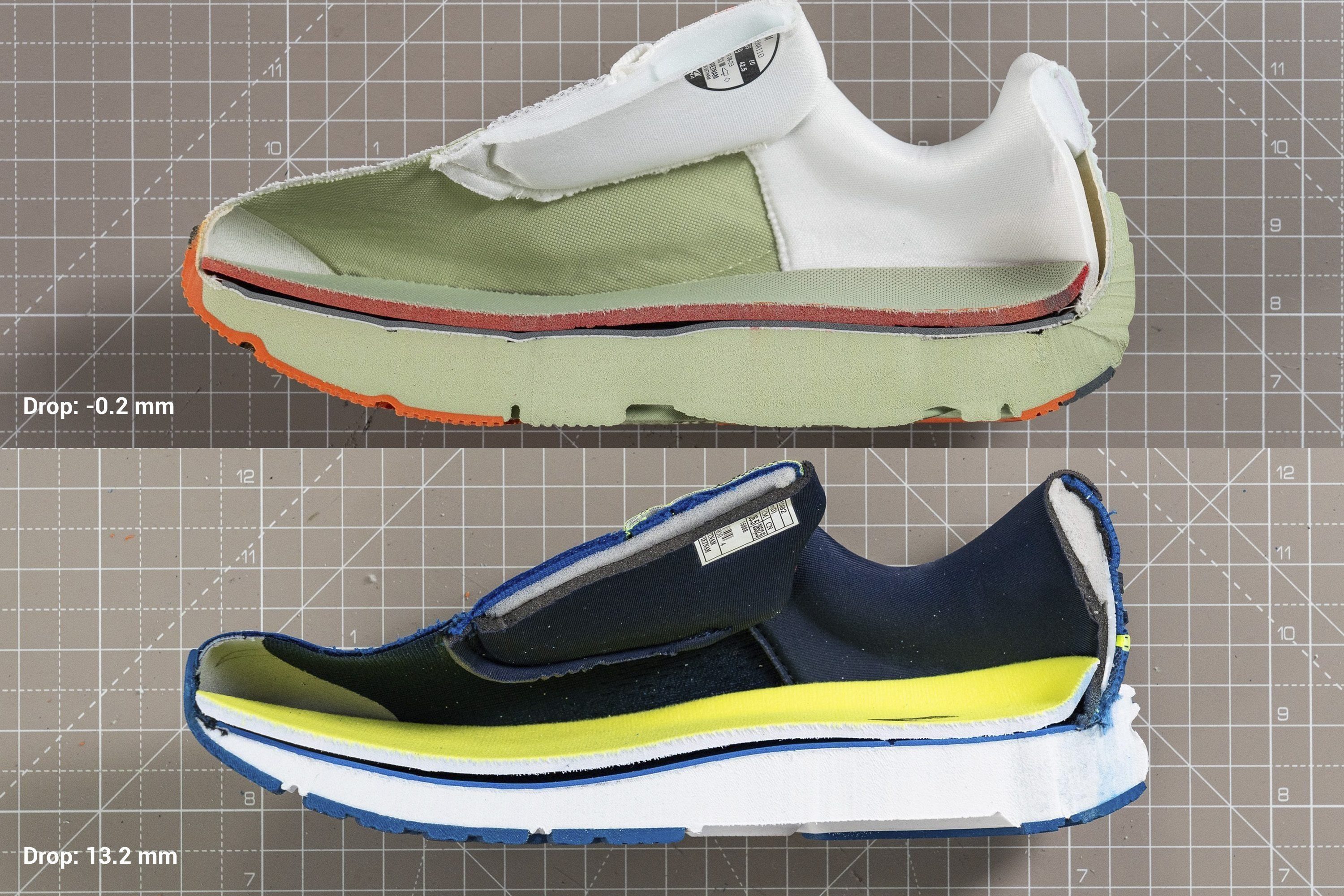
Lower drop (6mm and less) activates the muscles of the lower legs more, with zero drop using the feet muscles the most. Given that the plantar fascia is in your feet, it’s better to utilize muscles above your knees. A higher heel drop helps with that. We recommend running shoes with a heel drop of at least 8 mm.
|
Tip: If you want to learn more about heel drop, we highly recommend diving into our Heel to Toe Drop: The Ultimate Guide. |
It is worth noting that the rocker can sometimes help with activating the upper-leg muscles more, even in shoes with a lower drop.
Smooth transitions in a rockered running shoe
Too soft shoes are bad for plantar fasciitis
By now, we understand that we want to prevent the foot muscles from overworking. If they keep sinking into the very soft midsoles (that might even bottom out), feet must work more than usual to keep the toe-off effective and, well, running.
One of the softest running shoes we've tested: Hoka Mach X
While softer midsoles are more comfortable, it does not mean you should be wearing uncomfortable brick-alike shoes. Our general guideline is to go for a minimum of 20 HA on the durometer. And, if you know that the current average for all running shoes sits at 21.4 HA, you understand that we’re actually advising not to go for VERY soft only.
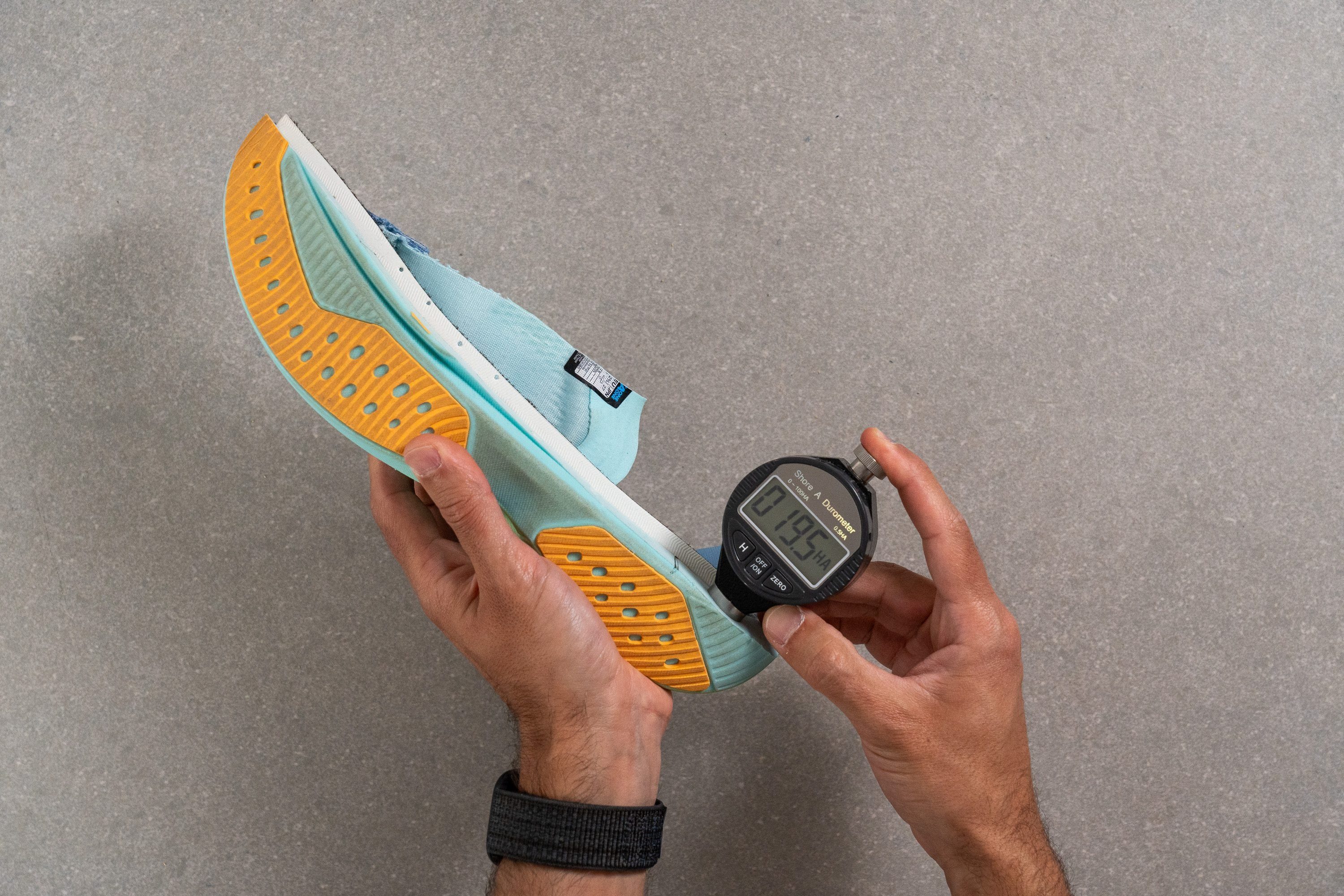
In our lab, we measure this softness by cutting the shoe in half and pressing a shore A durometer into the midsole foam. The lower the number on the durometer, the softer the foam.
You want them RIGID
Here, we’re focusing on torsional rigidity. How much the shoe twists? We recommend running shoes that are rigid.
Rigid running shoe that got a 4 out of 5 score for torsional rigidity in our lab
When testing torsional rigidity, we twist the shoes in our hands and assign them a 1-5 rating, where 1 is the least rigid and 5 is the most rigid. For plantar fasciitis, we’d go for the 3-5 rating for torsional rigidity.
These shoes are more stable and offer much-needed support to the feet troubled with plantar fasciitis. Shoes that are highly flexible (and especially low to the ground) allow for more natural-type of foot movement. This would make sense if your feet didn’t need the support and stability. Or, if you could run pain-free and with no triggering of the plantar fasciitis while barefoot.
Why stiff heel counters feel great when you have plantar fasciitis
Plantar fasciitis can manifest in pain under your arch, under your heel and around the heel. When it’s located around the heel, stiff heel counters feel awesome because they lock the heel in so there’s no necessary movement there.
Heel counter that we rated with 4 out of 5 for stiffness in RunRepeat lab
With very soft heel counters, heel area works more to stabilize the foot and compensate for uneven terrain. Stiff heel counters, together with the stiff base, make sure the load is not concentrated on the heel but evenly on the foot and that’s exactly how it feels: no extra work for the heel area!
We assess the stiffness of the heel counter on a 1-5 scale, where 5 is the stiffest. For plantar fasciitis, we recommend heel counters whose stiffness scored 3-5 on our test.
Example of a shoe with no heel counter: the stiffness is rated with 1 (the most flexible) and these heel counters are usually found in race shoes
Padding around the heel matters
It’s also important to note that the heel counters can be:
- not padded and maybe even harsh on the heel, and
- padded and very cozy.
Feet with plantar fasciitis might appreciate padded heel counters more if the heel area is very sensitive (painful to the touch). The extra material also protects the heel bone, which is appreciated.
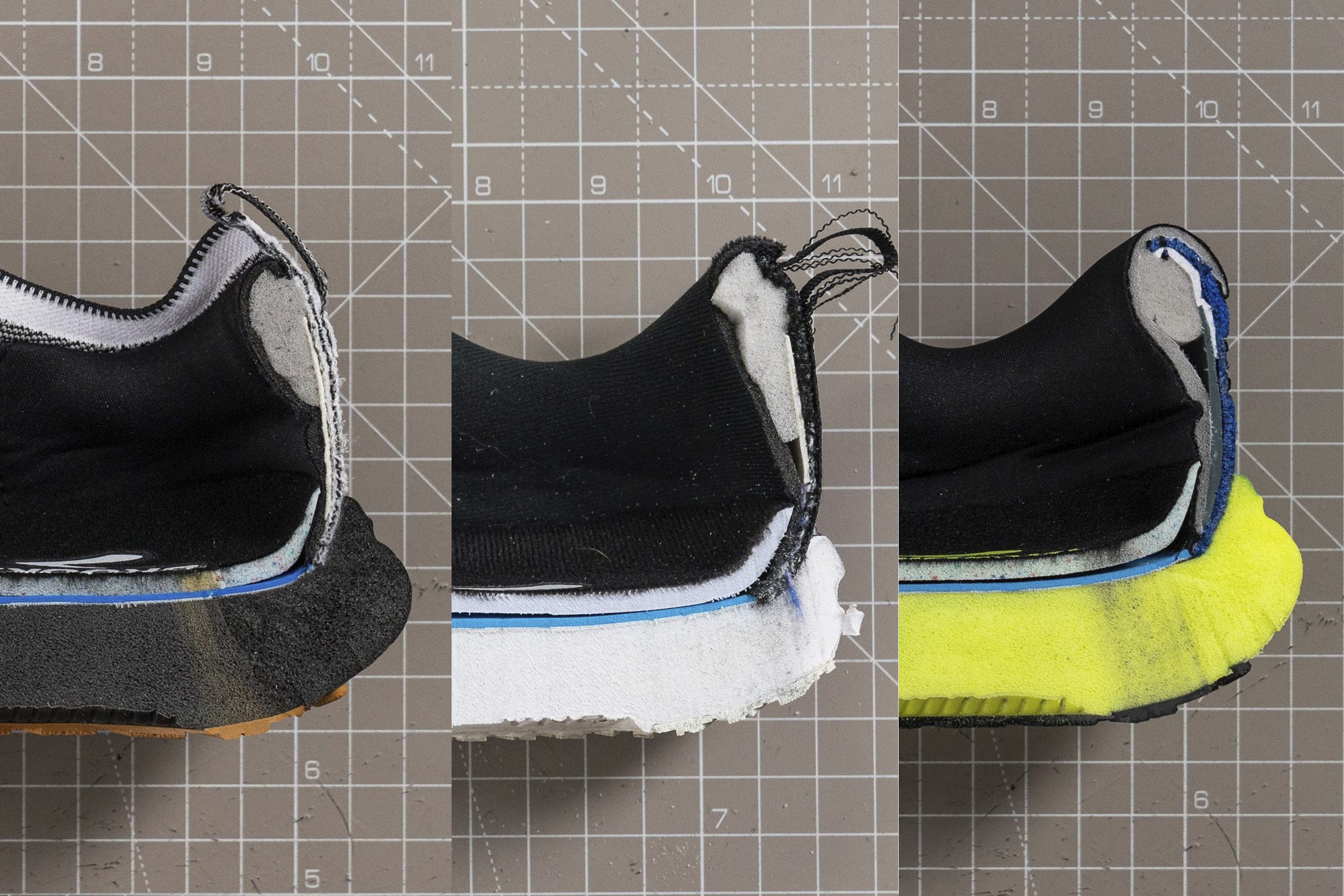
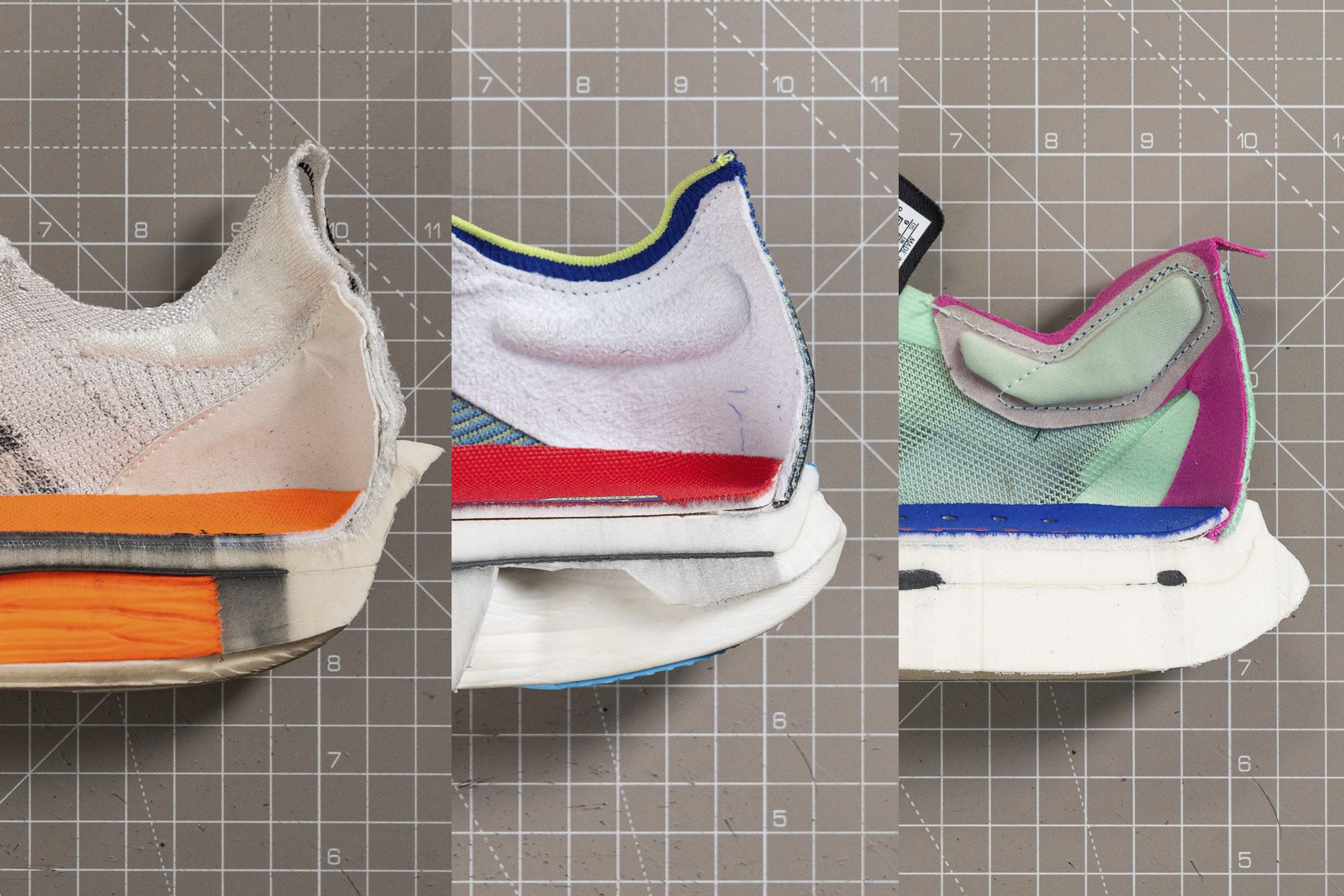
|
If the heel area is giving you trouble and you want to learn more about heel counters and how to find the perfect one for your needs, we recommend reading our in-depth guide: The role of heel counters in running shoes. |
Let your toes splay
It's also best not to have your toes cramped in the toebox when you have plantar fasciitis. That's actually never a good idea, but when it comes to plantar fasciitis, it's especially a bad one. To even start talking about the toebox volume, we have to make a mold that perfectly represents the shoe's interior.
Making a gel mold of the shoe's interior
When we take width measurements, we do that in 2 places, at the big toe and where the shoe is the widest. This allows us to understand how much the toebox tapers (how pointy it is) and it helps everyone understand if the shape and the width are right for them.
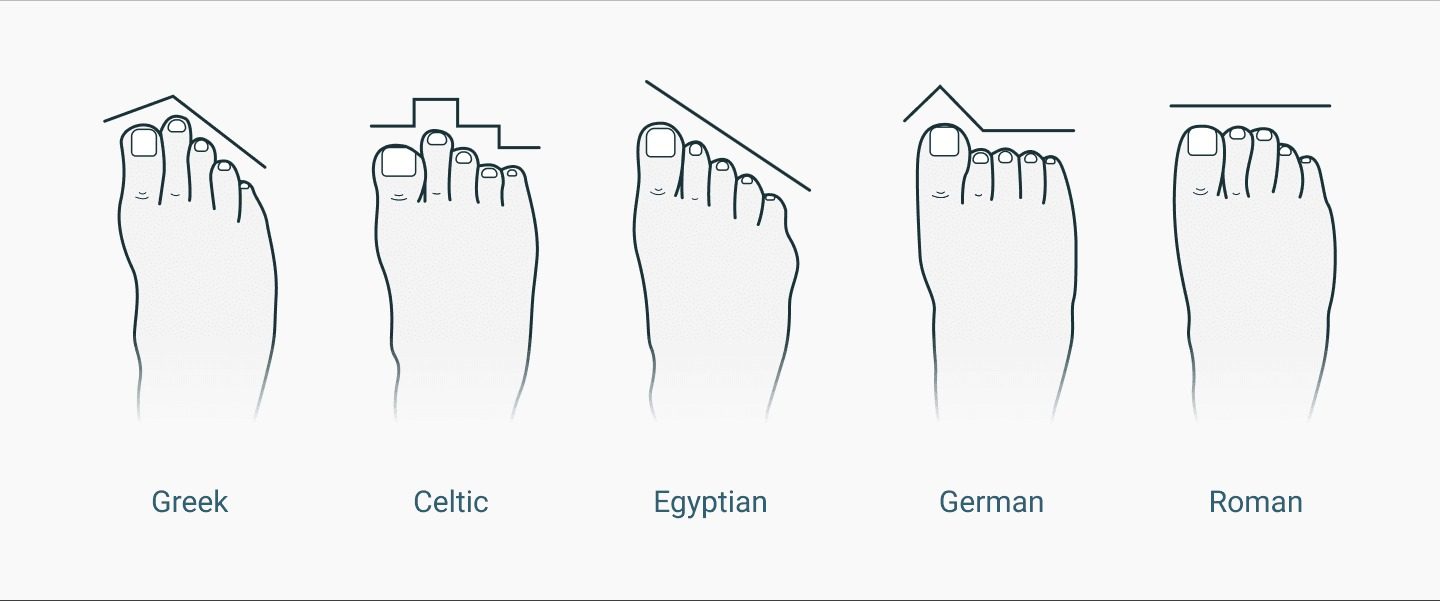
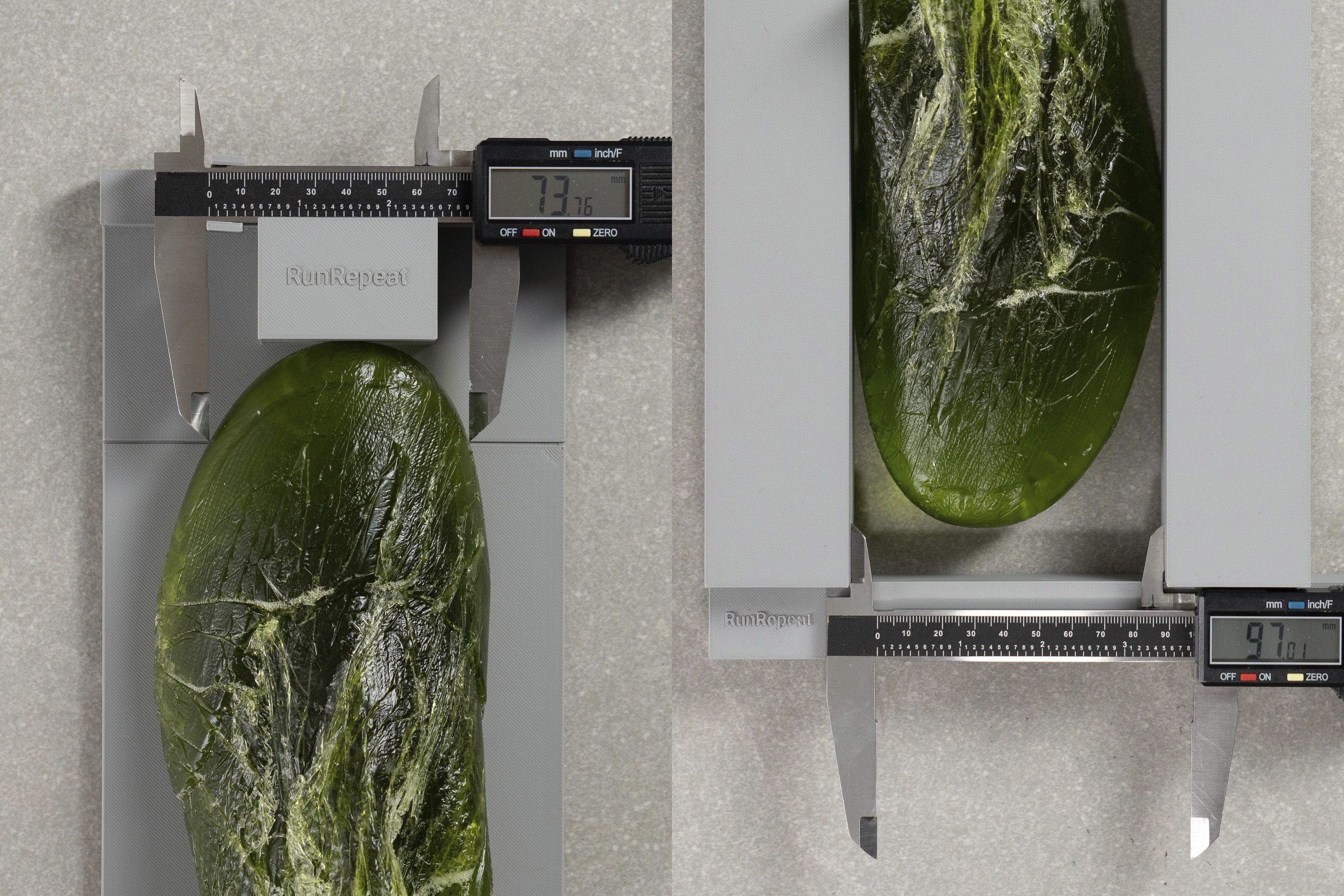
Knowing the shape of your toes is important because it will tell you where you may need more room.
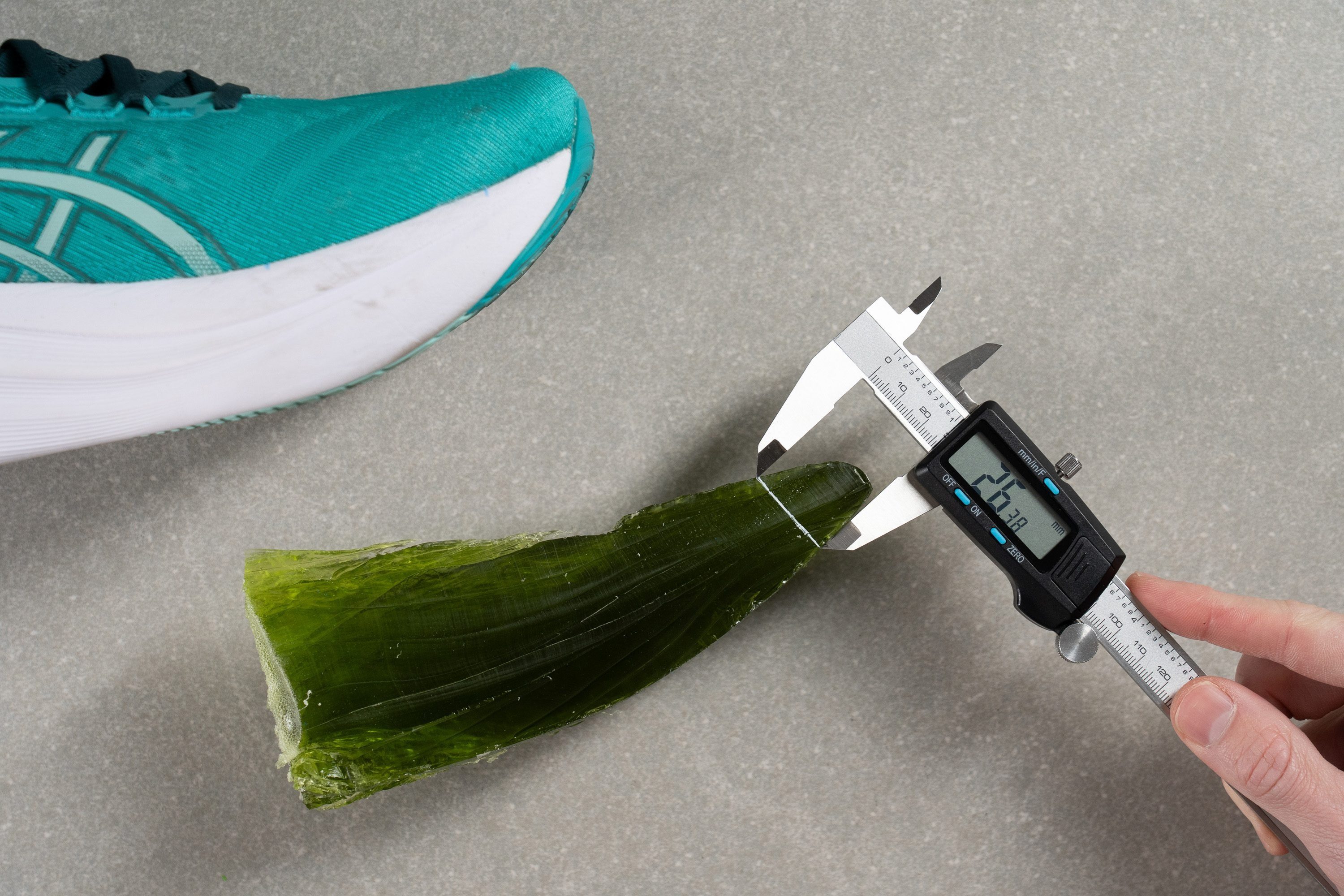
Noone should deal with pressure on top of the toes as it can lead to black toenails (to start with). If you already have some experience in this area, we recommend looking for shoes for plantar fasciitis with a high toebox:
In case you don't need just a wide toebox but a fit that's overall wide, look for shoes that are available in Wide or Extra-Wide.
| Narrow | Medium/Standard | Wide | Extra wide | |
| Men | B | D | 2E | 4E |
| Women | 2A | B | D | 2E |
Industry labels for different widths of running shoes
Keep in mind that not all brands have models available in different widths. From our experience and measurements, in most cases, it's the upper that is given more volume, while the base remains the same.

